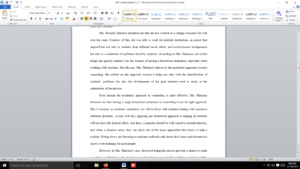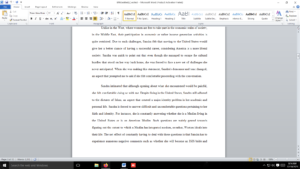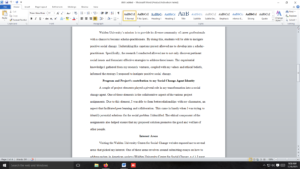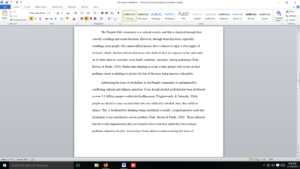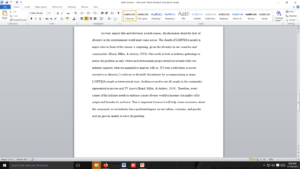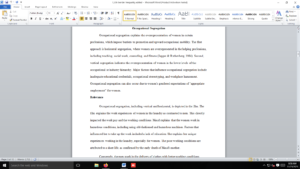Hi so this is the third paper in the class we already did two I will include them below.
This paper is supposed to be about a counseling interview with a person of choice. I will give you a name and than you can just say that you interviewed a friend. This paper has three parts to it. Each part is 2-4 pages. I want a total of 10 pages please do not do more or less. SO you have to pretend that you did an interview with that person and than write a paper based on it. The Paper has three parts and it is all explained in the prompt. In the two papers before we talked about using a theory and this theory you can use in the interview. You do not have to provide the interview itself just the three parts that are explain in the prompt. Please make sure to follow all the bullet points below each part and everything in APA and also the reference page. I will do the consent form part. For the references use the Diane Gehart book and you can use the same sources you have used in the paper before you have to have at least 5 if you want you can also find other academic sources. I will provide the link to the book.
Prompt:
Students will conduct a live mock interview with a colleague or student; record (audio or video) and write a case conceptualization paper. Students will write a theory-based case conceptualization that demonstrates their theoretical orientation and counseling skills. Students should demonstrate concepts learned throughout the program and coherently apply them to their own counseling practice. Students are expected to demonstrate an understanding of the program’s central tenets: multicultural responsiveness, social constructionist/postmodern theory, knowledge of trauma informed care and recovery movement principles.
Readings: Read articles and chapters related to counseling theory and single session interviews. Here, you may dive deeper into the research of your preferred orientation and counseling philosophy.
Instructor will be available to provide consultations, suggestions, and review student work over Zoom. The purpose of these meetings is to provide students with support, encouragement, and reflections in order to stay on track and complete the projects. They are voluntary.
Mock Interview Guidelines
You will be facilitating a one-time mock interview with a person over the age of 18. Who should you interview:
It would be useful for you to reflect on some questions you might want to ask based on your preferred theoretical orientation so that when you write your case conceptualization you have the relevant information. Imagine what may be useful to know if you are going to meet this person again and begin a collaborative helping relationship with them. Try and structure the interview so that it ends within 30-60 minutes (typical length of a regular counseling session). As this project is for a class assignment and will be audio or video recorded you will have to seek consent from your interviewee (see example “Consent form”) – both you and the interviewee must sign this form. This is NOT optional. You will submit the informed consent along with the reference page.
Since there will be no follow-up session planned, encourage the person to share something that was meaningful or important to them in the past – perhaps they can talk about a hurdle or difficulty they managed to overcome. We do not anticipate any negative effects from this conversation – in fact we hope that this will be a learning and growth experience for you and the interviewee. However, because it is impossible to know beforehand what may emerge in a conversation, make sure to check in with your interviewee periodically and at the end of the interview how the conversation is going for them. If they are impacted negatively by the conversation, provide them with information about a local counseling service or helpline.
Check in questions:
Ask periodically: How is this conversation going for you?
As you are nearing the end: Does this seem like an okay place for us to conclude this conversation? Is there anything else you would like to share about the situation that I have not asked about?
After you have ended: Do you have any comments or reflections on our conversation?
THE MAIN THREE PARTS BELOW
Case Conceptualization Requirements:
Section 1 (2-4 pages) Guidelines:
Provide a brief background of the interview.
What were you attempting to do during the interview?
Describe the core concepts and interventions of your theoretical orientation.
Describe your interventions, rationale, and the results.
How is this connected to your theory of counseling?
Be sure to reference specific portions of the interview; write at least two specific questions, comments, or responses during the interview.
Were there other possible paths the conversation could have taken?
Section 2 (2-4 pages) Guidelines:
How would trauma-informed care principles, restorative justice and/or recovery movement ideas inform how you think about your role as a counselor and the conversation that you had with the pretend counseling participant?
(my own comment: here about that part you can say that, In my trauma informed care with my Professor class I have learnt that as a counselor I am not the expert but the client is.) You can say that in some cases it is helpful to let clients also take over and find a solution) (You can google that idea further). Identify some ideas from trauma informed and restorative justice that are connecting to you as the role of a counselor)
Describe any possible ethical and legal issues. No need to go through the process of resolving the possible ethical or legal issue.
Discuss any referrals and consultations that would be helpful if needed.
Section 3 (2-4 pages) Guidelines:
Situate Yourself: How do your own beliefs, background and priorities affect the way that you are thinking about this conversation?
Situate yourself vis-a-vis your own experience—how does it relate or not relate to your own lived experiences?
How does your own social and political location related to your gender, sexual orientation, class, race-ethnicity, citizenship status and/or ability capacities influence your “reading” of the topic? In what ways do your privileges impact how you are constructing meaning and knowledge?
(My own comment: I am a Middle Eastern female who is an immigrant in the US, I always dreamt of education because in my culture girls become housewives and so on.) You can say that even I was raised a certain way this does not affect any counseling conversation I have I try not to bias and so on. So I am female, straight, lower to middle class, middle eastern and so on. for more information let me know.
Appendices
1.Reference Page: If needed, continue adding more sources to your reference page. Draw upon and cite at least 5 different significant or primary sources. You may incorporate resources or writings from previous modules, lectures, and excerpts of your work from prior courses. You should utilize appropriate graduate-level material from research articles and books. Textbooks can provide you with a helpful overview to think about a topic, however, you should seek out and utilize primary sources for your paper.
2.Signed Consent Form: Submit a copy from your interview informed consent:
The paper should balance your own reflections with the literature/research; be sure to include citations and maintain connections with the authors.


